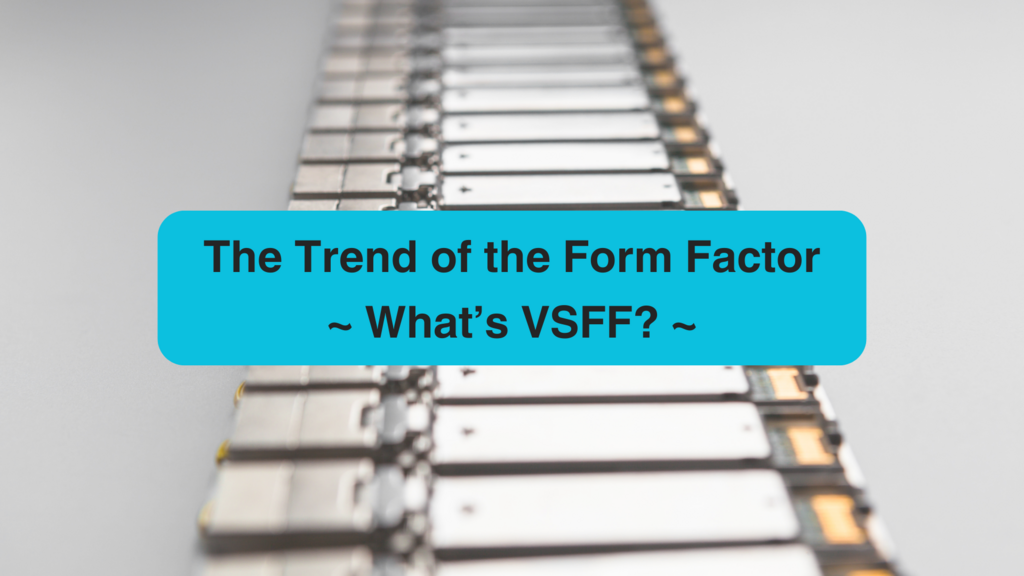The latest trend in form factors – What's VSFF? –

Technology Trends in Data Centers
Demand for data centers is rapidly increasing with the spread of AI technology and the expansion of cloud services. With communication volume predicted to increase approximately seven-fold between 2020 and 2030, increasing data center density and improving power efficiency have become urgent issues. To address this issue, the form factors of optical transceivers and optical connectors are becoming smaller.
* Form factor is a general term for factors that determine the shape and size of hardware. Specifically, it refers to the layout of storage devices such as hard disks and motherboards, and the standards and layout of optical transceivers and external connectors.
Miniaturization of optical transceivers
Optical transceivers are important optical devices that convert electrical signals into optical signals in data centers, enabling high-speed and efficient data transmission. In recent years, they have rapidly become smaller and faster, evolving from conventional 100G and 200G modules to 400G and 800G.
The transition to miniaturization
The miniaturization and high speed of optical transceivers have contributed greatly to the efficiency of data centers. Optical transceivers, which were 5 x 7 inches (12.7 cm x 17.8 cm) in size around 2012, have now been miniaturized to the QSFP-DD size of about 2 cm x 8 cm. At the same time, transmission speeds have increased from 100 Gbit/s to 400 Gbit/s, and power consumption has been reduced to one-quarter.
Technology Trends
The latest technological trend is the development of optical transceivers that can achieve transmission speeds of 400 Gbps and 800 Gbps. These high-speed transceivers are also undergoing integration using silicon photonics technology, which has significantly reduced the size of conventional optical devices and made it possible to integrate them with electronic circuits.
Miniaturization of optical connectors
Optical connectors are also becoming smaller, and very small form factor (VSFF) connectors, which enable higher density connections than conventional MPO connectors, are attracting attention.
Technology Trends
SENKO Advanced Components
The SN-MT connector developed by SENKO Advance offers a new option to the VSFF connector market. The SN-MT connector uses a clever design that achieves 2.7 times the density of an MPO connector in a 16-Fiber version while maintaining the same footprint as an SN connector. It combines high performance with ease of use, including low loss (Single-mode insertion loss of 0.15 dB) and improved operability (push-pull boot).
USConec
USConec's Multi-fiber Miniature Connector (MMC) is a breakthrough product that achieves three times the connection density of conventional MPO connectors. The newly developed Tiny MT (TMT) ferrule technology achieves further miniaturization while inheriting the reliable alignment structure of conventional MT Ferrule. MMC combines high performance and ease of use, such as low insertion loss (IEC Grade B performance) and easy insertion and removal (DirectConec™ Push-Pull technology).
Data center benefits from smaller devices
Merit
- Densification: Smaller size allows more devices to be installed in the same space, significantly increasing data center capacity.
- Less power consumption: Smaller devices consume less power, improving the overall power efficiency of data centers.
- Higher speeds: Smaller size shortens the distance signals need to be transmitted, enabling faster data communication.
- Cost savings: Improved space efficiency reduces capital and operational costs.
- Greater flexibility: Smaller devices allow greater flexibility in changing data center layouts and configurations.
Challenges with adopting new devices
- Compatibility: You need to ensure that new small devices are compatible with your existing infrastructure.
- Cooling efficiency: As device densities increase, it becomes necessary to design efficient cooling systems.
- Increased management complexity: With more devices to manage, an efficient operations management system is required.
- Initial investment: Introducing new technology requires an initial investment.
- Improving engineers' skills: Developing and securing engineers who can handle new technologies is a challenge.
summary
To meet the demands of higher density and power saving in data centers, optical modules and connectors are rapidly becoming smaller. The emergence of VSFF connectors, such as SENKO Advance's SN-MT connector and USConec's MMC connector, has significantly improved the efficiency and performance of data centers.
The adoption of these small devices offers many benefits, including higher density in data centers, lower power consumption, faster speeds, reduced costs, and improved flexibility, but also brings new challenges, such as ensuring compatibility, improving cooling efficiency, and dealing with increased management complexity.
The importance of data centers is expected to increase further with the spread of 5G communications, IoT, and the development of AI. The evolution of small form factor devices will be a key technology to meet this demand.
reference:
・ USConec/MMC Connector
・ SENKO/SN-MT Connector
・ QSFP-DD MSA
・ OSFP MSA
If you have any questions or inquiries about our company,
Please feel free to contact us.
